百度排序技術的探索與應用
一、背景
首先來介紹百度綜合資訊流推薦的業務背景、資料背景,以及基本的演算法策略。
1、百度綜合資訊流推薦
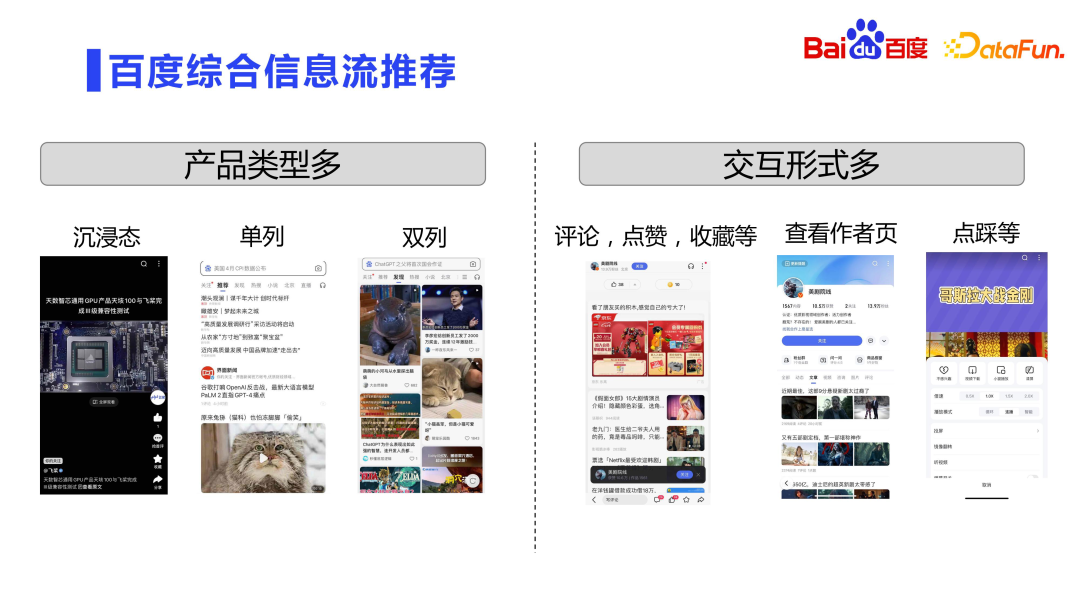
#百度的綜合資訊流包含在手百APP中搜尋框的清單頁以及沉浸頁的形態,涵蓋了多種產品類型。從上圖可以看到,推薦內容的形式有類似抖音的沉浸態推薦,也有單列和雙列推薦,類似小紅書筆記的版面。用戶與內容的交互方式也非常多樣,可以在落地頁上進行評論、點讚、收藏,還可以進入作者頁查看相關信息並進行交互,用戶還可以提供負向的反饋等等。整個綜合資訊流的設計非常豐富多樣,能夠滿足使用者不同的需求和互動方式。
2、資料背景
從建模的角度來看,主要面對三方面的挑戰:

- 大規模##。每天的展現量級超過了百億級,因此模型需要有天級別百億的吞吐能力。每天的 DAU 過億,這也決定了整個模型需要有高吞吐、高可擴展性的設計。對於排序模型來說,在線每秒鐘有數億次的計算,因此模型設計時不僅要考慮效果,同時也要考慮性能,需要做到很好的性能和效果的折中。使用者互動形態以及場景的多樣化,也要求模型可以預估多類型任務。
- 高要求。 整個系統的回應時間需求非常高,端到端都是毫秒的運算,超過了預定的時間,就會回傳失敗。這也造成了另一個問題,就是複雜結構上線困難。
- 馬太效應強。 從資料樣本角度來看,馬太效應非常強,少量的頭部活躍用戶貢獻了大多數的分發量,頭部的熱門資源也覆蓋到了大多數的展現量。無論是使用者側或資源側,馬太效應都是非常強的。因此,系統設計時就需要弱化馬太效應,使得推薦更公平。
3、基本演算法策略
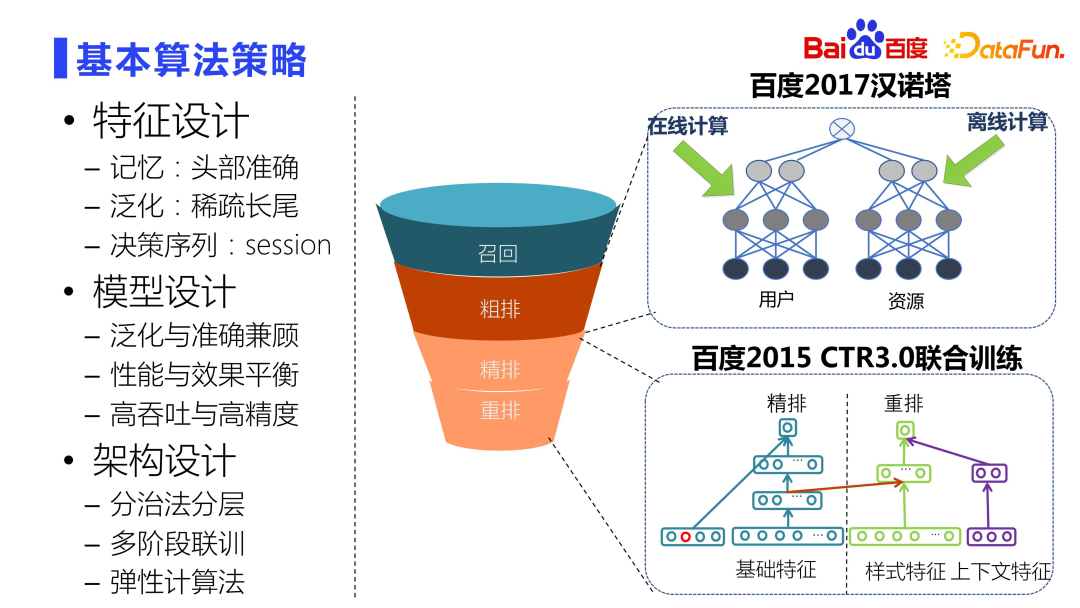
#在整個產業界的推廣在搜場景上,特徵設計通常採用離散化的方式,以確保記憶和泛化兩方面的效果。特徵透過哈希方式轉換為one-hot編碼進行離散化處理。對於頭部用戶,需要進行精細刻畫,以實現準確的記憶。而對於佔比較大的稀疏長尾用戶,則需要進行良好的泛化處理。此外,在使用者的點擊和消費決策序列中,session扮演著非常重要的角色。
模型設計需要平衡頭部和長尾的資料分佈,確保準確性和泛化能力。特徵設計已經考慮到了這一點,因此模型設計也需要同時考慮到泛化和準確性。百度推薦漏斗對效能要求非常嚴格,因此需要在架構和策略上進行聯合設計,找到效能和效果的平衡點。此外,還需要平衡模型的高吞吐性和精確度。
架構的設計需要從效能和效果兩個維度綜合考慮。一個模型無法處理數千萬的資源庫,因此必須進行分層設計,核心思想是分治法。各層之間存在關聯,因此需要進行多階段的聯訓,以提升多階段漏斗之間的效率。此外,還需要採用彈性計算法,在資源幾乎不變的情況下,能夠上線複雜的模型。
上圖中右側的漢諾塔項目,在粗排這一層非常巧妙地實現了用戶與資源的分離建模。還有CTR3.0 聯合訓練,實現了多層多階段的聯訓,例如精排,是整個系統中最複雜、最精緻的模型,精度是相當高的,重排是在精排之上做list wise 的建模,精排跟重排的關係是很緊密的,我們提出的基於這兩個模型聯訓的方式,取得了非常好的線上效果。
接下來,將分別從特徵、演算法和架構三個角度進一步展開介紹。
##1、用戶-系統互動決策過程
特徵描述了使用者與系統之間的互動決策過程。
下圖中展示了使用者-資源-場景-狀態時空關係交互矩陣圖。
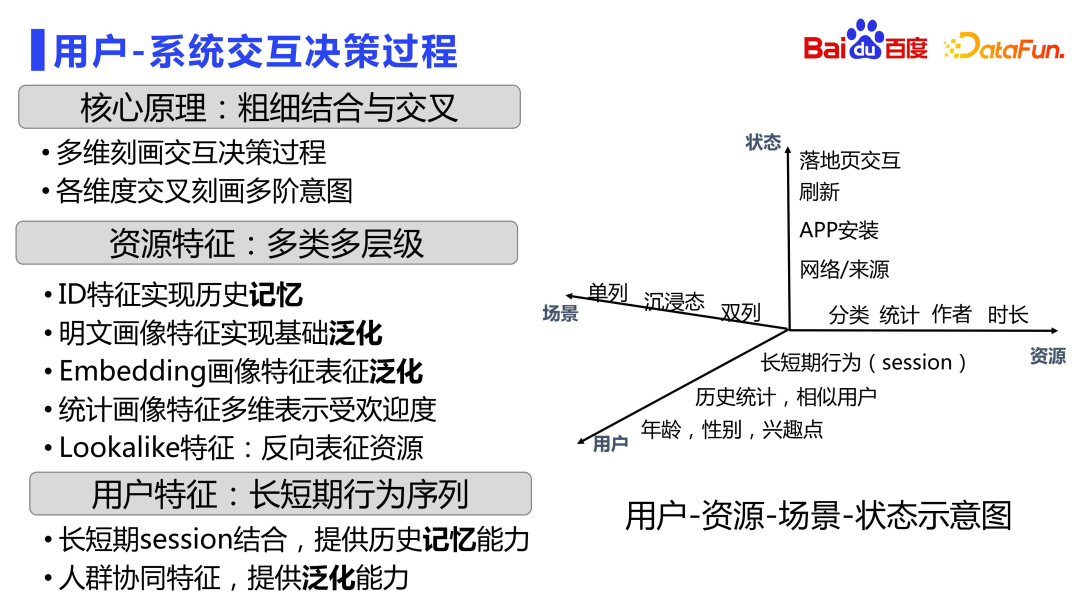
首先將所有訊號切分為使用者、資源、場景和狀態這四個維度,因為本質上是要建模使用者與資源之間的關係。在每個維度上,可以做各種各樣的畫像資料。
使用者維度上,最基礎的年齡、性別、興趣點畫像。在此基礎上還會有一些細微的特徵,例如相似用戶,以及用戶歷史上對不同資源類型的偏好行為等。 session 特徵,主要是長短期行為序列。業界有很多做序列的模型,在此不作贅述。但無論做何種類型的序列模型,都缺少不了特徵層面的離散 session 特徵。在百度的搜尋廣告上,從10 多年前就已經引入了這一種細粒度的序列特徵,對用戶在不同的時間窗口上,對不同資源類型的點擊行為、消費行為等等都細緻地刻畫了多組序列特徵。
資源維度上,也會有 ID 類別特徵來記錄資源本身的情況,主導的是記憶。還有明文畫像特徵來實現基礎的泛化能力。除了粗粒度的特徵以外,也會有更細緻的資源特徵,例如 Embedding 畫像特徵,是基於多模態等預訓練模型產出的,更細緻地建模離散 embedding 空間中資源之間的關係。還有統計畫像類別的特徵,描述資源各種情況下的後驗如何。以及 lookalike 特徵,透過使用者來反向表徵資源進而提升精度。
在場景維度上,有單列、沉浸式、雙列等不同的場景特徵。
使用者在不同的狀態下,對於 feed 資訊的消費也是不同的。例如刷新狀態是如何的,是從什麼樣的網路過來的,以及落地頁上的互動形態是怎麼樣的,都會影響到使用者未來的決策,所以也會從狀態維度來描述特徵。
透過使用者、資源、狀態、場景四個維度,全面刻畫使用者與系統互動的決策過程。很多時候也會做多個維度之間的組合。
2、離散特徵設計原理
#接下來介紹離散特徵設計原理。
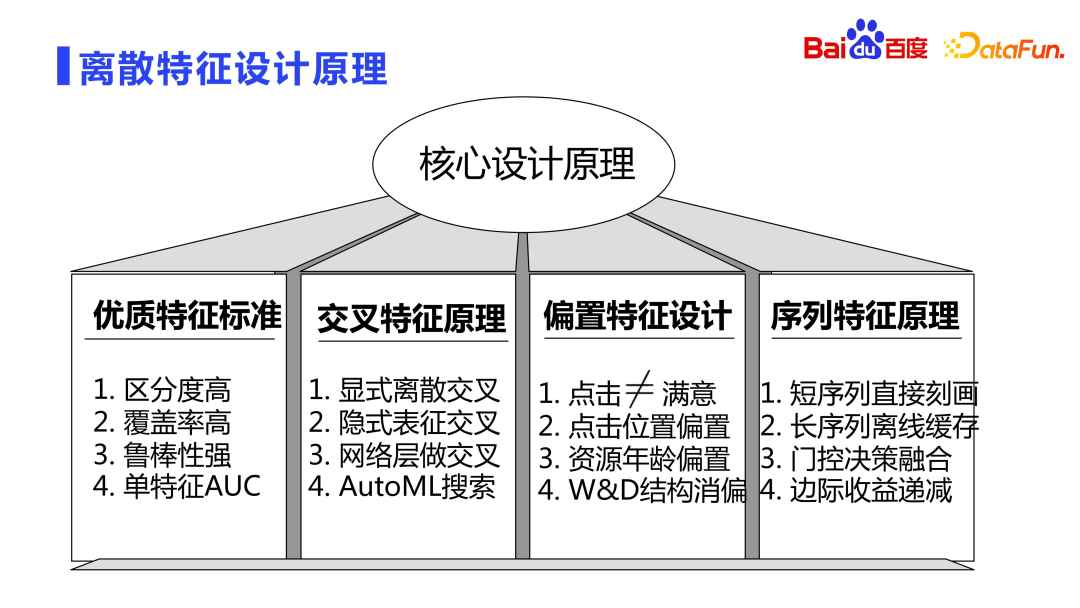
優質的特徵通常有三個特點:區分度高、覆蓋率高、穩健性強。
- 區分度高:加入特徵後,後驗有著很大差異。例如加入 a 特徵的樣本,後驗點擊率跟沒有命中 a 特徵的後驗點擊率差距是非常大的。
- 覆蓋率高:如果加入的特徵在整個樣本中的覆蓋率只有萬分之幾、十萬分之幾,那麼即使特徵很有區分度,但大機率也是沒有效果的。
- 穩健性強:特徵本身的分佈要是相對穩定的,不能隨著時間發生非常劇烈的變化。
除了上述三個標準,還可以做單一特徵的 AUC 判斷。例如只用某一特徵來訓練模型,看特徵跟目標的關係。也可以去掉某個特徵,看少了特徵之後的 AUC 變化。
基於上述設計原則,我們來重點討論三類重要特徵:即交叉、偏移和序列特徵。
- Regarding cross-features, there are hundreds of related works in the industry. In practice, it has been found that no type of implicit feature cross-over can completely replace explicit feature cross-over, nor can it combine all All cross-features are deleted and only implicit representations are used. Explicit feature intersection can depict relevant information that implicit feature intersection cannot express. Of course, if you go deeper, you can use AutoML to automatically search the possible feature combination space. Therefore, in practice, the cross between features is done mainly by explicit feature cross and supplemented by implicit feature cross.
-
The bias feature refers to the fact that user clicks do not equal user satisfaction, because there are various biases in the display of resources, such as the most common The problem is position bias. Resources displayed in the header are naturally more likely to be clicked. There is also system bias. The system gives priority to showing what it thinks is the best, but it is not necessarily the real best. For example, newly released resources may be at a disadvantage due to lack of posterior information.
There is a very classic structure for biased features, which is the Wide&Deep structure proposed by Google. Various biased features are usually placed on the Wide side, which can be cropped directly online. out, and achieve the effect of unbiased estimation through this partial ordering method. - #The last is the sequence feature, which is a very important type of user personalized feature. The current mainstream in the industry is to model very long sequences. In specific experiments, it will be found that the storage overhead of long sequences is usually very large. As mentioned in the previous article, we need to achieve a compromise between performance and effect. Long sequences can be pre-calculated offline, and short sequences can be calculated online in real time, so we often combine the two methods. The gating network is used to decide whether the user currently prefers short sequences or long sequences to balance long-term interests and short-term interests. At the same time, it should be noted that the marginal benefit decreases as the sequence lengthens.
3. Optimized feature system of recommendation funnel
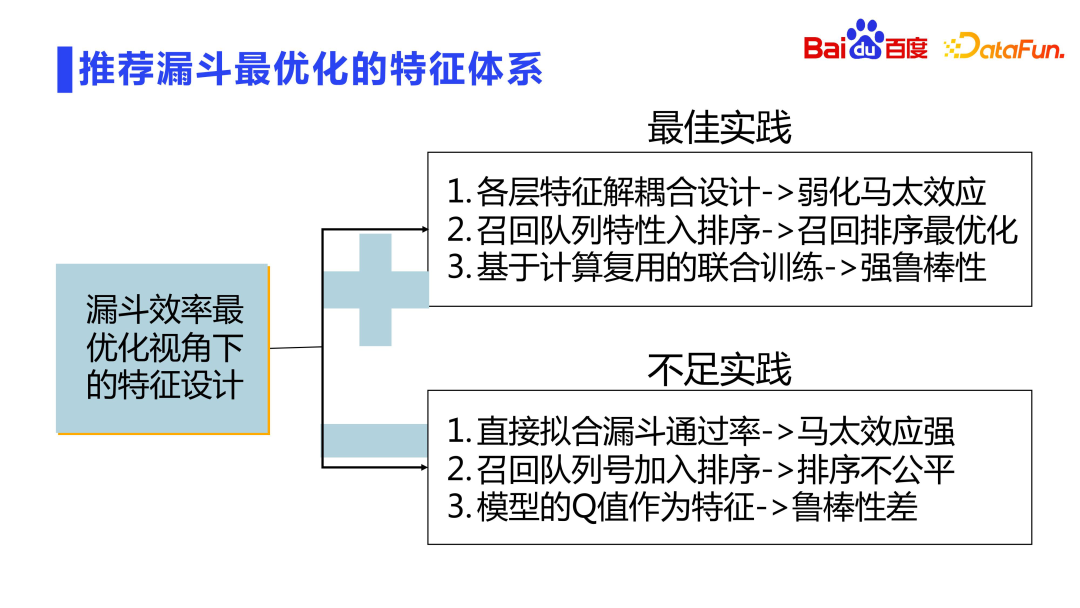
Entire recommendation The funnel is designed in layers, with filtering and truncation at each layer. How to achieve maximum efficiency in a layered design with filter truncation? As mentioned earlier, we will do joint training of models. In addition, related designs can also be done in the dimension of feature design. There are also some problems here:
- First of all, in order to improve the funnel pass rate, recall and rough sorting are directly fitted to fine ranking or fine sorting, which will lead to further strengthening of the Matthew effect. At this time , the recall/rough ranking model does not drive the learning process based on user behavior, but rather a fitting funnel. This is not the result we want to see. The correct approach is to recommend the decoupling design of each layer of the funnel model, rather than directly fitting the lower layer of the funnel.
- The second aspect is rough sorting, which is theoretically closer to recall and is essentially the outlet for unified recall. Therefore, at the level of rough sorting, more recall signals can be introduced, such as crowd voting signals for collaborative recommendation, graph index paths, etc., so that rough sorting can be jointly optimized with the recall queue, so that the recall efficiency of resources entering fine sorting can be improved optimize.
- The third is calculation reuse, which can improve the robustness of the model while reducing the amount of calculation. It should be noted here that there are often cascaded models. The second-level model uses the scores of the first-level model as features. This approach is very risky because the final estimated value of the model is an unstable distribution. If the estimated value of the first-level model is directly used as a feature, the lower-level model will be severely coupled, causing system instability.
##3. Algorithm
The following introduces the core algorithm the design of.
1. Sorting model from a system perspective
First let’s look at the recommended sorting model. It is generally believed that fine ranking is the most accurate model in the recommendation system. There is a view in the industry that rough layout is attached to fine layout and can be learned from fine layout. However, in actual practice, it has been found that rough layout cannot be directly learned from fine layout, which may cause many problems.
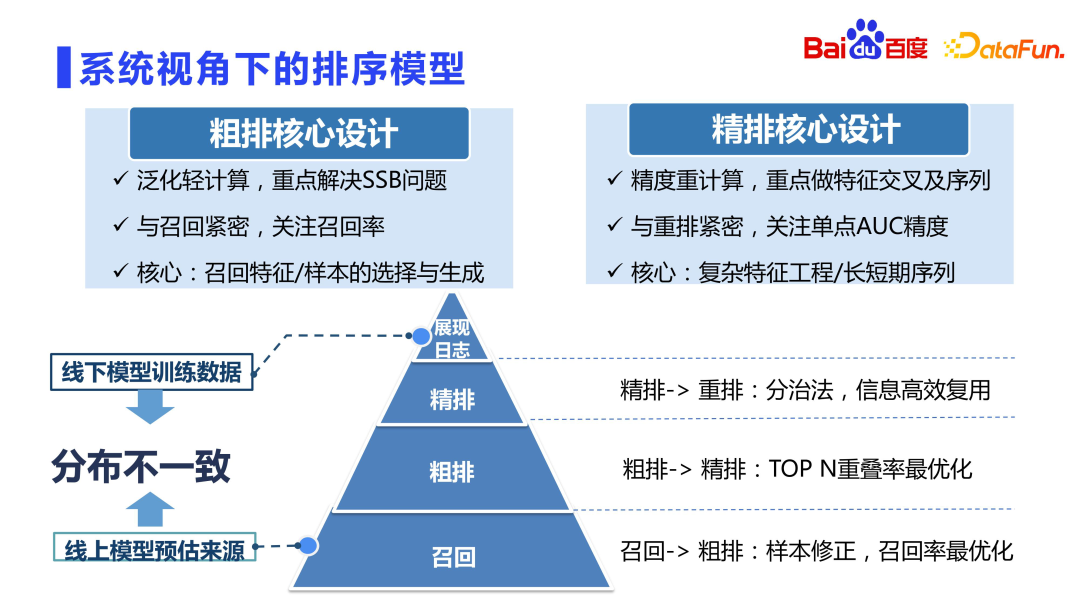
As you can see from the picture above, the positioning of rough sorting and fine sorting is different. Generally speaking, the rough sorting training samples are the same as the fine sorting samples, which are also display samples. Each time there are tens of thousands of candidates recalled for rough ranking, more than 99% of the resources are not displayed, and the model only uses a dozen or so resources that are finally displayed for training, which breaks the independence Under the assumption of identical distribution, the distribution of offline models varies greatly. This situation is most serious in recall, because the recall candidate sets are millions, tens of millions or even hundreds of millions, and most of the final returned results are not displayed. Rough sorting is also relatively serious. Because the candidate set is usually in the tens of thousands. The fine sorting is relatively better. After passing through the two-layer funnel of recall and rough sorting, the basic quality of resources is guaranteed. It mainly does the work of selecting the best from the best. Therefore, the problem of offline distribution inconsistency in fine ranking is not so serious, and there is no need to consider too much the problem of sample selection bias (SSB). At the same time, because the candidate set is small, heavy calculations can be done. Fine ranking focuses on feature intersection, sequence modeling, etc. .
However, the level of rough sorting cannot be directly learned from fine sorting, nor can it be directly recalculated similar to fine sorting, because the calculation amount is dozens of times that of fine sorting. Times, if you directly use the design idea of fine layout, the online machine will be completely unbearable, so rough layout requires a high degree of skill to balance performance and effect. It is a lightweight module. The focus of rough sorting iteration is different from fine sorting, and it mainly solves problems such as sample selection bias and recall queue optimization. Since rough sorting is closely related to recall, more attention is paid to the average quality of thousands of resources returned to fine sorting rather than the precise sorting relationship. Fine ranking is more closely related to rearrangement and focuses more on the AUC accuracy of a single point.
Therefore, in the design of rough ranking, it is more about the selection and generation of samples, and the design of generalization features and networks. The refined design can do complex multi-order intersection features, ultra-long sequence modeling, etc.
2. Generalization of very large-scale discrete DNN
The previous introduction is at the macro level, let’s take a look at the micro level.
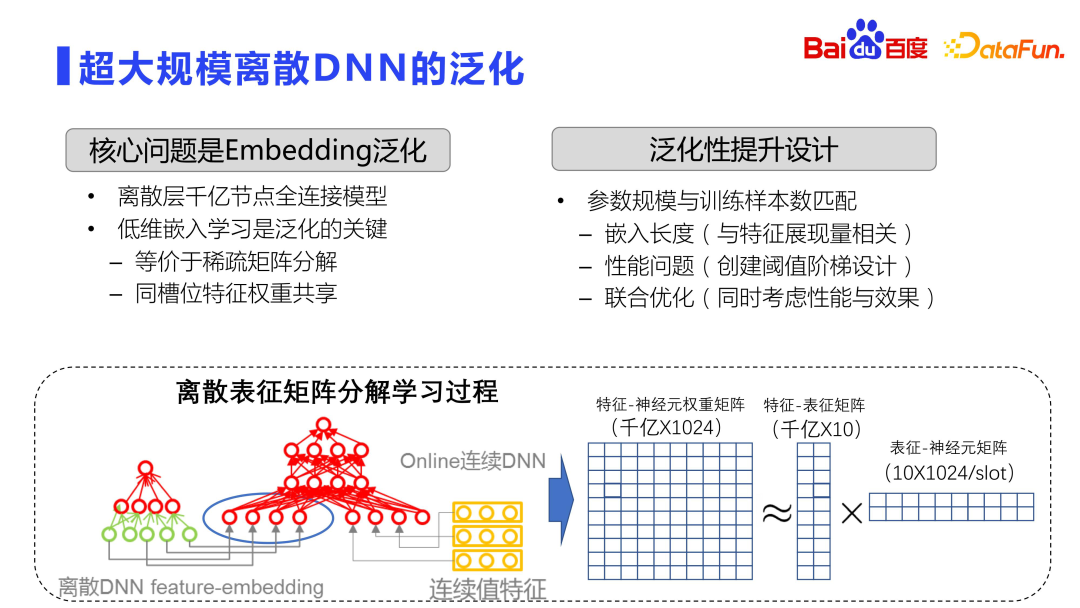
# Specific to the model training process, the current mainstream in the industry is to use ultra-large-scale discrete DNN, and the generalization problem will be more serious. Because ultra-large-scale discrete DNN, through the embedding layer, mainly performs the memory function. See the figure above. The entire embedding space is a very large matrix, usually with hundreds of billions or trillions of rows and 1,000 columns. Therefore, model training is fully distributed, with dozens or even hundreds of GPUs doing distributed training.
Theoretically, for such a large matrix, brute force calculations will not be performed directly, but operations similar to matrix decomposition will be used. Of course, this matrix decomposition is different from the standard SVD matrix decomposition. The matrix decomposition here first learns the low-dimensional representation, and reduces the amount of calculation and storage through the sharing of parameters between slots, that is, it is decomposed into two matrices. the process of learning. The first is the feature and representation matrix, which will learn the relationship between the feature and the low-dimensional embedding. This embedding is very low, and an embedding of about ten dimensions is usually selected. The other one is the embedding and neuron matrix, and the weights between each slot are shared. In this way, the storage volume is reduced and the effect is improved.
Low-dimensional embedding learning is the key to optimizing the generalization ability of offline DNN. It is equivalent to doing sparse matrix decomposition. Therefore, the key to improving the generalization ability of the entire model lies in how to make it Parameter size can be better matched with the number of samples.
Optimize from multiple aspects:
- #First of all, from the embedding dimension, because of the display of different features The quantity difference is very large. The display quantity of some features is very high, such as head resources and head users. You can use longer embedding dimensions. This is the common idea of dynamic embedding dimensions, that is, the more fully the embedding dimensions are displayed. The longer. Of course, if you want to be more fancy, you can use autoML and other methods to do reinforcement learning and automatically search for the optimal embedding length.
- #The second aspect is to create thresholds. Since different resources display different amounts, when to create embedded representations for features also needs to be considered.
3. Overfitting problem
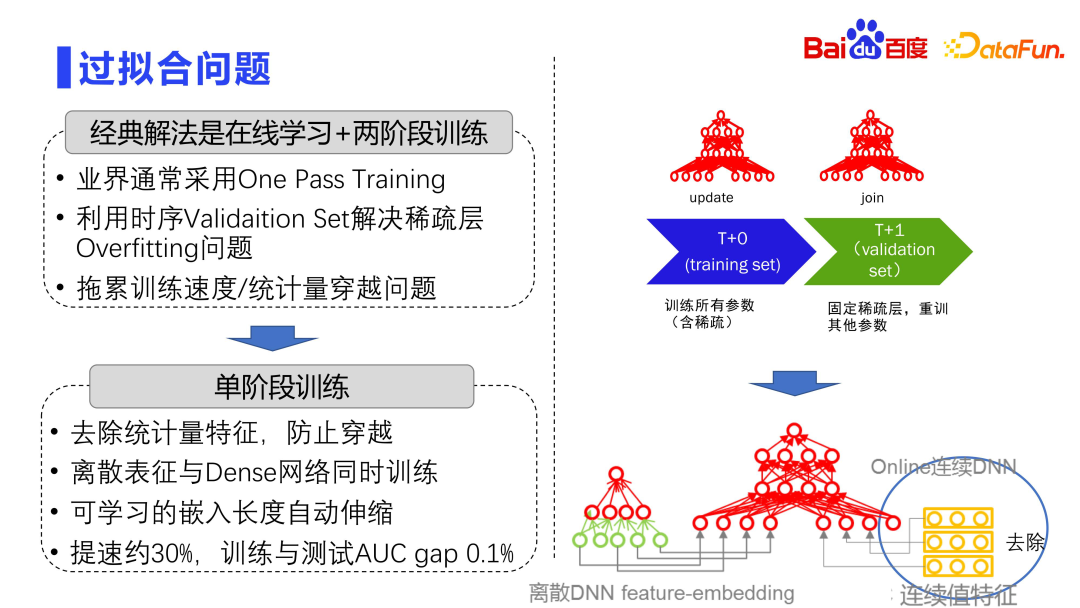
The industry usually adopts a two-stage training method to resist overfitting. The entire model consists of two layers, one is a large discrete matrix layer, and the other is a small dense parameter layer. The discrete matrix layer is very easy to overfit, so industry practice usually uses One Pass Training, that is, online learning, where all the data is passed through, and batch training is not done like in academia.
In addition, the industry usually uses timing validation set to solve the overfitting problem of sparse layers. Divide the entire training data set into many Deltas, T0, T1, T2, and T3, according to the time dimension. Each training is fixed with the discrete parameter layer trained a few hours ago, and then the next Delta data is used to finetune the dense network. That is, by fixing the sparse layer and retraining other parameters, the overfitting problem of the model can be alleviated.
This approach will also bring another problem, because the training is divided, and the discrete parameters at time T0 need to be fixed each time, and then the join is retrained at time t 1 stage, this will slow down the entire training speed and bring scalability challenges. Therefore, in recent years, single-stage training has been adopted, that is, the discrete representation layer and the dense network layer are updated simultaneously in a Delta. There is also a problem with single-stage training, because in addition to embedding features, the entire model also has many continuous-valued features. These continuous-valued features will count the display clicks of each discrete feature. Therefore, it may bring the risk of data crossing. Therefore, in actual practice, the first step will be to remove the statistical features, and the second step will be to train the dense network together with the discrete representation, using a single-stage training method. In addition, the entire embedded length is automatically scalable. Through this series of methods, model training can be accelerated by about 30%. Practice shows that the degree of overfitting of this method is very slight, and the difference between the AUC of training and testing is 1/1000 or lower.
##4. Architecture
Next, we will introduce the architecture design thoughts and experiences.
1. Principle of system layered design
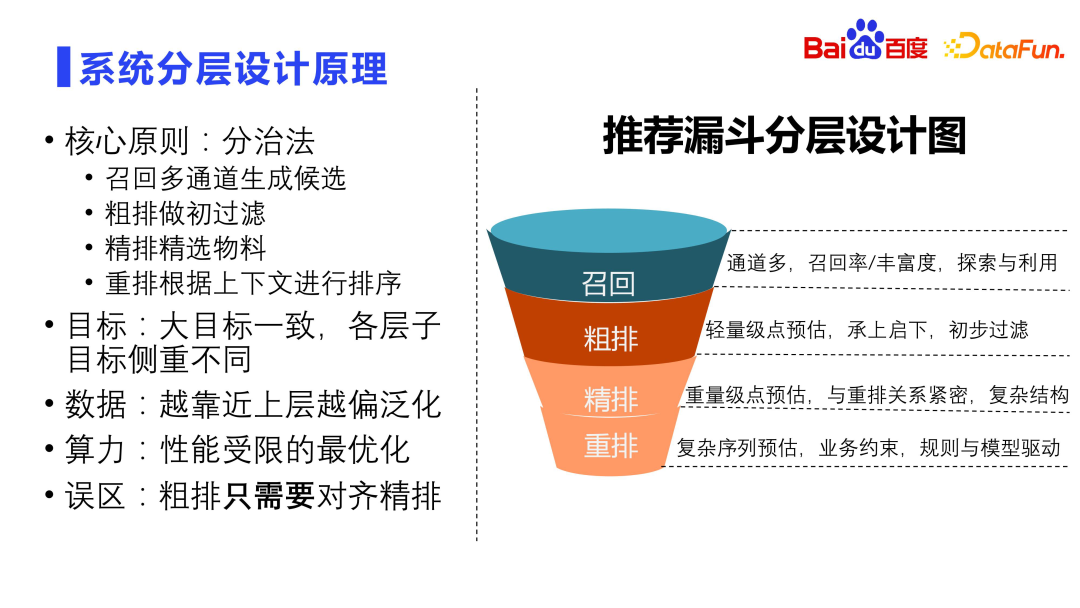
effect. Because fine ranking is not the ground truth, user behavior is. You need to learn user behavior well, not learn fine ranking. This is a very important tip.
2. Multi-stage model joint training
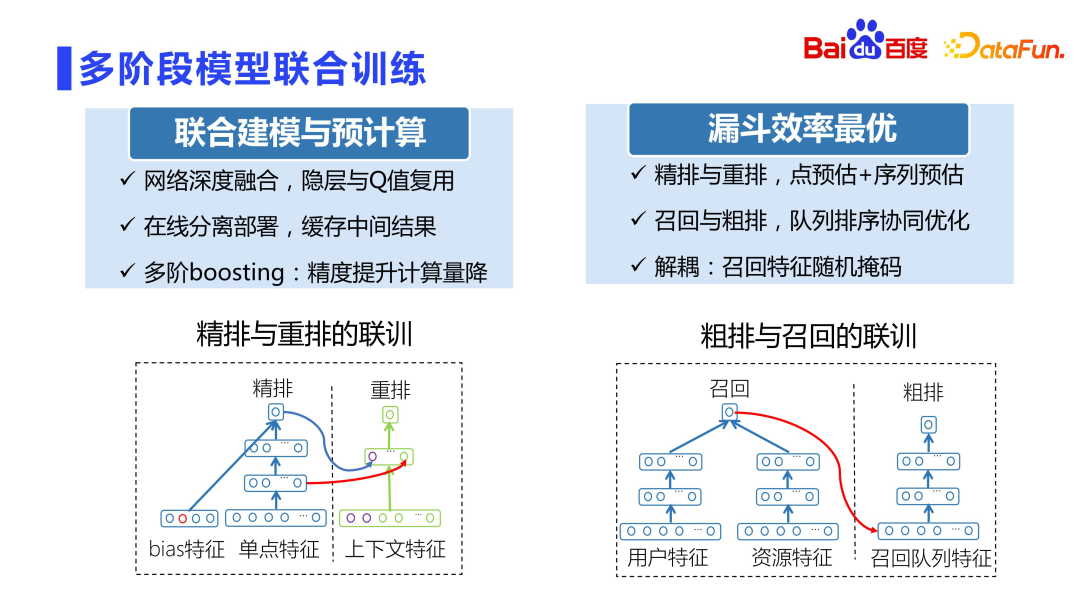
#The relationship between fine ranking and rearrangement is It is very close. In the early years, rearrangements were directly trained using the scores of fine lineups. On the one hand, the coupling was very serious. On the other hand, the scores of fine lineups were directly used for training, which easily caused online fluctuations.
Baidu Fengchao CTR 3.0 joint training project of fine ranking and rearrangement very cleverly uses models to train at the same time to avoid the problem of scoring coupling. This project uses the hidden layer and internal scoring of the fine-ranking sub-network as characteristics of the rearrangement sub-network. Then, the fine-ranking and rearrangement sub-networks are separated and deployed in their respective modules. On the one hand, the intermediate results can be reused well without the fluctuation problem caused by scoring coupling. At the same time, the accuracy of rearrangement will be improved by a percentile. This was also one of the sub-projects that received Baidu’s highest award that year.
In addition, please note that this project is not ESSM. ESSM is CTCVR modeling and multi-objective modeling. CTR3.0 joint training mainly solves the problems of scoring coupling and rearrangement model accuracy. .
In addition, recall and rough sorting must be decoupled, because new queues are added, which may not be fair to the new queues. Therefore, a random masking method is proposed, that is, randomly masking out some features so that the coupling degree is not so strong.
3. Sparse routing network
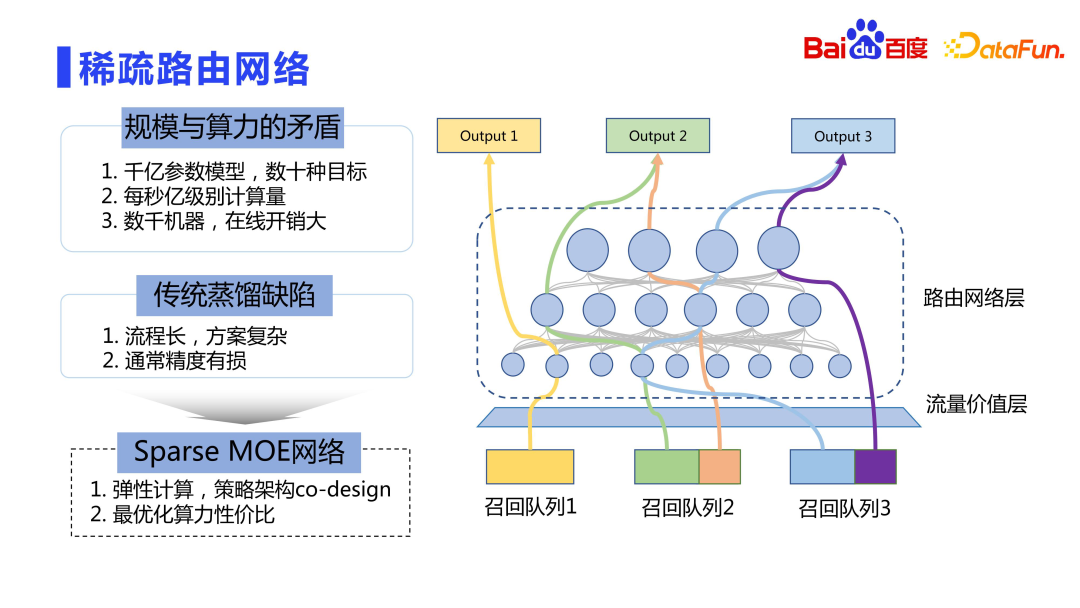
Finally, let’s take a look at the online deployment process. The scale of model parameters is in the order of hundreds of billions to trillions, and there are many targets. Direct online deployment is very expensive, and we cannot only consider the effect without considering the performance. A better way is elastic calculation, similar to the idea of Sparse MOE.
Rough sorting has access to a lot of queues, with dozens or even hundreds of queues. The online value (LTV) of these queues is different. The traffic value layer calculates the value of different recall queues to online click duration. The core idea is that the greater the overall contribution of the recall queue, the more complex calculations can be enjoyed. This allows limited computing power to serve higher value traffic. Therefore, we did not use the traditional distillation method, but adopted an idea similar to Sparse MOE for elastic computing, that is, the design of strategy and architecture co-design, so that different recall queues can use the most suitable resource network for calculation.
##5. Future plans
As we all know, now Entering the era of LLM large models. Baidu's exploration of the next generation recommendation system based on LLM large language model will be carried out from three aspects.
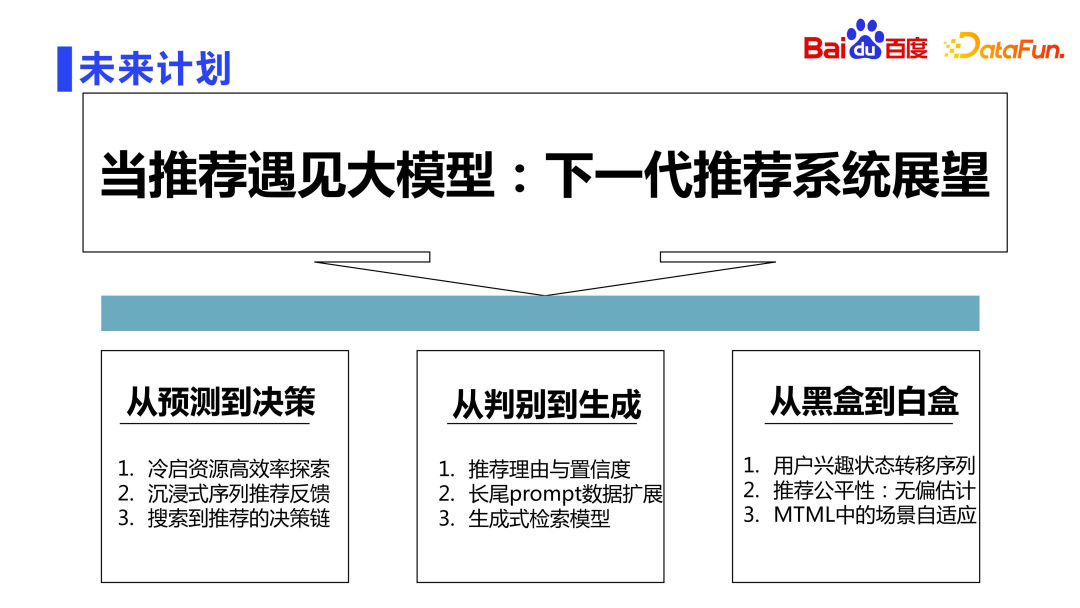
The first aspect is to upgrade the model from basic prediction to being able to make decisions. For example, important issues such as efficient exploration of classic cold start resources, immersive sequence recommendation feedback, and the decision-making chain from search to recommendation can all be made with the help of large models.
The second aspect is from discrimination to generation. Now the entire model is discriminative. In the future, we will explore generative recommendation methods, such as automatically generating recommendation reasons, and based on long-tail data prompt for automatic data enhancement and generative retrieval model.
The third aspect is from black box to white box. In the traditional recommendation system, people often say that neural network is an alchemy and a black box. Is it possible to move towards white box? Exploration is also one of the important tasks in the future. For example, based on cause and effect, we can explore the reasons behind user behavior state transitions, make better unbiased estimates of recommendation fairness, and perform better scene adaptation in Multi Task Machine Learning scenarios.
以上是百度排序技術的探索與應用的詳細內容。更多資訊請關注PHP中文網其他相關文章!

熱AI工具

Undresser.AI Undress
人工智慧驅動的應用程序,用於創建逼真的裸體照片

AI Clothes Remover
用於從照片中去除衣服的線上人工智慧工具。

Undress AI Tool
免費脫衣圖片

Clothoff.io
AI脫衣器

Video Face Swap
使用我們完全免費的人工智慧換臉工具,輕鬆在任何影片中換臉!

熱門文章

熱工具

記事本++7.3.1
好用且免費的程式碼編輯器

SublimeText3漢化版
中文版,非常好用

禪工作室 13.0.1
強大的PHP整合開發環境

Dreamweaver CS6
視覺化網頁開發工具

SublimeText3 Mac版
神級程式碼編輯軟體(SublimeText3)
 最佳AI藝術生成器(免費付款)創意項目
Apr 02, 2025 pm 06:10 PM
最佳AI藝術生成器(免費付款)創意項目
Apr 02, 2025 pm 06:10 PM
本文回顧了AI最高的藝術生成器,討論了他們的功能,對創意項目的適用性和價值。它重點介紹了Midjourney是專業人士的最佳價值,並建議使用Dall-E 2進行高質量的可定製藝術。
 Chatgpt 4 o可用嗎?
Mar 28, 2025 pm 05:29 PM
Chatgpt 4 o可用嗎?
Mar 28, 2025 pm 05:29 PM
Chatgpt 4當前可用並廣泛使用,與諸如ChatGpt 3.5(例如ChatGpt 3.5)相比,在理解上下文和產生連貫的響應方面取得了重大改進。未來的發展可能包括更多個性化的間
 開始使用Meta Llama 3.2 -Analytics Vidhya
Apr 11, 2025 pm 12:04 PM
開始使用Meta Llama 3.2 -Analytics Vidhya
Apr 11, 2025 pm 12:04 PM
Meta的Llama 3.2:多模式和移動AI的飛躍 Meta最近公佈了Llama 3.2,這是AI的重大進步,具有強大的視覺功能和針對移動設備優化的輕量級文本模型。 以成功為基礎
 最佳AI聊天機器人比較(Chatgpt,Gemini,Claude&更多)
Apr 02, 2025 pm 06:09 PM
最佳AI聊天機器人比較(Chatgpt,Gemini,Claude&更多)
Apr 02, 2025 pm 06:09 PM
本文比較了諸如Chatgpt,Gemini和Claude之類的頂級AI聊天機器人,重點介紹了其獨特功能,自定義選項以及自然語言處理和可靠性的性能。
 頂級AI寫作助理來增強您的內容創建
Apr 02, 2025 pm 06:11 PM
頂級AI寫作助理來增強您的內容創建
Apr 02, 2025 pm 06:11 PM
文章討論了Grammarly,Jasper,Copy.ai,Writesonic和Rytr等AI最高的寫作助手,重點介紹了其獨特的內容創建功能。它認為Jasper在SEO優化方面表現出色,而AI工具有助於保持音調的組成
 選擇最佳的AI語音生成器:評論的頂級選項
Apr 02, 2025 pm 06:12 PM
選擇最佳的AI語音生成器:評論的頂級選項
Apr 02, 2025 pm 06:12 PM
本文評論了Google Cloud,Amazon Polly,Microsoft Azure,IBM Watson和Discript等高級AI語音生成器,重點介紹其功能,語音質量和滿足不同需求的適用性。
 如何訪問獵鷹3? - 分析Vidhya
Mar 31, 2025 pm 04:41 PM
如何訪問獵鷹3? - 分析Vidhya
Mar 31, 2025 pm 04:41 PM
獵鷹3:革命性的開源大語模型 Falcon 3是著名的獵鷹系列LLMS系列中的最新迭代,代表了AI技術的重大進步。由技術創新研究所(TII)開發
 構建AI代理的前7個代理抹布系統
Mar 31, 2025 pm 04:25 PM
構建AI代理的前7個代理抹布系統
Mar 31, 2025 pm 04:25 PM
2024年見證了從簡單地使用LLM進行內容生成的轉變,轉變為了解其內部工作。 這種探索導致了AI代理的發現 - 自主系統處理任務和最少人工干預的決策。 Buildin






